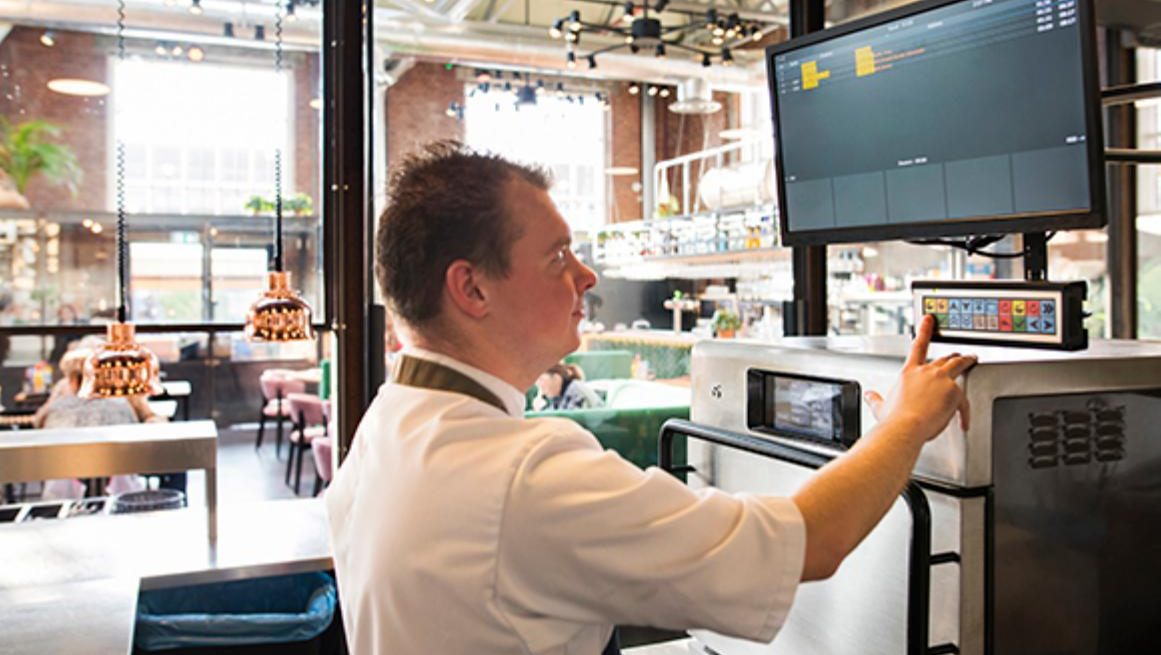Your Restaurant’s Technology Touchpoints
6 Min Read By Devyn Nance, QSR Automation
When it comes to equipment that helps your restaurant run more efficiently, you’ve probably encountered phrases like “add this to your technology stack” or “these solutions will help simplify your restaurant.” Maybe you’re a smaller operation with less than five units in one state or a mom-and-pop operation with one location that’s been in the family for years. Perhaps you’re a large restaurant chain that has locations all over the country? If you fit into any of these categories and you’re wondering why restaurant technology is a worthwhile investment, then keep reading. Let’s review how restaurant technology can assist you with your daily operations.
Front-of-House
Henry is ready to order some dinner. He visits your restaurant’s app and orders his favorite dish on the menu. He receives an estimated wait time for his order of 45 minutes.
Forty-five minutes later, Henry arrives at your restaurant. As he is about to enter the restaurant, let’s consider the technology that he will encounter along his journey to pick up his order.
Contactless Technology
We’ve seen restaurants pivot to contactless methods for a safer customer experience. In the case of Henry, he’s entered the restaurant and encountered a small stand with a QR code and a sheet of instructions. Henry takes his phone, scans the QR code, and indicates that he’s arrived. He’s then directed to numbered cubbies and finds his order waiting in the indicated cubby. Henry leaves the restaurant with his fuel to continue his binge-watching marathon.
Additionally, Henry could have encountered an order ready screen as he entered the restaurant. He would have found his name on the screen, been guided to the cubbies, and given a cubby number from the order-ready screen. Once again, his food is fresh, and he doesn’t have to wait a long time in either scenario.
Outside of off-premise options, contactless technologies can keep customers safe as they return to dine-in at restaurants. Customers enter the restaurant and approach the host stand. They’ve walked in, so they are expecting a wait. The host has added them to the waitlist, and they immediately receive a text giving approximate wait time and notify them when their table is ready. Depending on the restaurant’s location, they won’t have to return to their vehicle to wait immediately but can shop while waiting.
Once they receive the table-ready SMS notification, they return to the host stand. Then they are guided to scan a QR code to access the menu. In many restaurants, customers can also pay via the QR code online at the end of their meal. Thus, limiting interaction with restaurant employees and giving customers peace of mind as we navigate the customer experience through a progressively post-pandemic lens.
Guest Management & Waitlist
Speaking of the host stand, let’s take a deeper look at your guest and waitlist management technology. This piece in your technology stack should give your customers accurate wait times based on the tables already seated and allow them to make reservations so they can plan around current capacity limits or patronize your restaurant for special occasions.
Let’s come back to Henry. He wants to meet up with a group of friends for the weekend and decides to make a reservation at your restaurant. He conducts a quick Google search and makes a reservation with a few easy clicks from Google. As Henry’s reservation date approaches, your restaurant needs a robust piece of technology that allows you to communicate with Henry and Henry to communicate with you if he needs to modify his reservation. Either way, with your restaurant’s efficient and straightforward guest management, waitlist, and reservation technology, Henry has no worries about his reservation.
When it comes to your waitlist management, there’s no need for paper, pens, and clipboards. Your host stand solution should:
- Allow you to customize your floor maps based on your restaurant’s layout
- Maintain crowd sizes to keep with social distancing guidelines
- Communicate with other technology in your restaurant
- Use data to allow you to make informed decisions for your restaurant
- Streamline the order ahead process for you and your customers
Why shouldn’t you have technology that allows your staff to work smarter and make your customers’ experience as seamless as possible?
Point of Sale
Now, we’ve reached your point of sale. Your POS should be able to integrate with your restaurant’s technology, whether the back or front-of-house. Make your restaurant’s operations as seamless as possible and keep in mind that a POS is not the only piece of technology that you need to quote order-ready times to customers, but we’ll get to that later.
Essentially (as if you didn’t already know), your POS is where the order originates. Once the order is input into the system, would you rather have your order immediately routed to the kitchen through your POS? We think so! Also, with the right point of sale, you’ll be able to integrate not only with a quality kitchen display system but with off-premise apps as well!
Your customers will interact with the point of sale early in their journey with your restaurant. Whether they place their order via an app, physically at the restaurant, or online, make sure your POS is connected to the rest of your technology stack to provide guests with an accurate and efficient experience every visit!
Back-of-House
Your customers aren’t ever going to be in your kitchen, but your back-of-house technology is also an essential part of their experience with your restaurant.
Returning to Henry, let’s take a step back and follow along through the back-of-house. He’s placed his order through your restaurant’s app. The order goes through the POS and is routed to your kitchen display system. It’s a vital technology touchpoint to note because ideally, you want your kitchen display system to route the parts of Henry’s order where they need to be for him to have the freshest food and more!
Kitchen Display System
The right kitchen display system for your technology arsenal receives Henry’s routed order from the POS and sends it to different stations based on the food he’s ordered. Let’s say Henry orders a salad, a burger, fries, and a baked dessert. Once he places his order and goes through the POS, his burger is routed to the grill station. The salad doesn’t fire; your technology will “hold” it to ensure that it will finish closer to Henry’s arrival. The baked good goes to the appropriate station. As all of this is taking place, the kitchen display system quotes an accurate order ready time based on the orders in the kitchen when the order is received, whether off-premise or dine-in.
Which features are important in a robust kitchen display system to make sure Henry’s food will be fresh when he arrives forty-five minutes?
- Bin management – prepare your kitchen for a rush and ensure that capacity capability reflects accurately so that your customers wait the amount of time they were given. Make sure you have enough food to keep hot and fresh and not get overwhelmed during a rush period.
- Flexible APIs – connect all of the technology in your stack so that each piece is sharing data for accurate information for everyone in your restaurant. Besides, you can add more technology to your business without having to change too much.
- Recipe viewing capability – streamline your training efforts and make changing your menu a breeze! You can save paper and you don’t have to print out a recipe book for each dish, but create something that’s easily accessible for your staff at any time during their shift. This makes training a breeze and can help you reduce turnover.
Hardware
Finally, let’s talk hardware! Your hardware is also an important part of your technology stack because it compliments your software. Your kitchen display system needs reliable hardware. A kitchen display controller is the hardware that controls the kitchen display system. In the order’s journey, the order is placed through the POS, hits the controller, and then organizes the information and then pushes it through. Consider the different types of controllers based on your business goals. Do you want a more robust controller that has graphical displays and enables images to appear on screen? That would allow your staff to see recipes and an image of the completed dish. If you have a smaller business that doesn’t need that many bells and whistles, then a text-only controller may be the right option for you.
Another hardware option to consider in your smart kitchen is a kitchen display bump bar. Your restaurant needs a bump bar that can handle the heat! Once an order component is complete, the bump bar is there to help move it along. Using the bump bar is vital to maintain accuracy in quoting times and the data that’s shared across your technology arsenal.
Conclusion
There are so many places in which customers like Henry can come into contact with technology. These “touchpoints” are great opportunities for your restaurant to create a seamless and efficient guest experience. Using the right technology can be an essential solution to help you work smarter, not harder. Wouldn’t it be great for these touch points to all be connected and speaking to each other to make Henry and your other customers happy now and in the future?


